 BU-07447
BU-074472005
![]()
 BU-07447
BU-07447
2005
| Home | Next |
Sustainable Landscapes and Management |
Native plants can be used around homes and in gardens to create sustainable landscapes. Most native plants are perennial and have extensive root systems that hold soil and slow runoff. Persistent stems, leaves, and flower parts which remain through the winter also reduce runoff, especially in the spring, as snow melts and rainfall begins before new growth is present. Particulate matter accumulates around these native plants and the plants themselves absorb chemicals such as nitrogen and phosphorous that would otherwise enter the runoff.
Native plants have many positive characteristics. Native plants used as buffer strips along water margins slow runoff and absorb nutrients. They are also self-sustaining, and they support wildlife including beneficial insects, pollinators, and native birds.
Successfully growing native plants requires an understanding of the evolutionary adaptations plants make to specific light and soil moisture conditions. Prairie plants have adapted to dry, sunny uplands, while woodland plants tolerate shade. Wet meadows contain plants species tolerant of sun and wet soils, while plant species in the emergent zone grow with their stems above water and their roots in water. Submerged or floating leaf plants have stems and leaves under water with some parts above water.
Once established, these landscapes can be managed by using principles of Integrated Pest Management, which emphasize lower pesticide usage. These sustainable landscapes require less chemical treatment, reducing the amount of chemicals put into the environment which have nontargeted effects on the ecosystem, its plants, and its animals.
This bulletin contains information on sustainable landscaping in watersheds, sustainable management of such landscapes, lists of vendors who sell native plants and erosion control materials, and an extensive list of recommended native plants. Landscapes and their management are described for drier upland gardens as well as shoreline buffer strips.

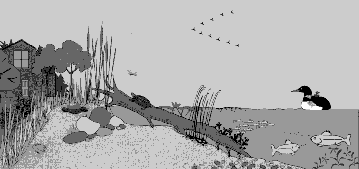
Convert upland gardens and shorelands to wildlife havens by planting native species and practicing sustainable management. (MNDNR). Copyright 1998, State of Minnesota, Department of Natural Resources, Section of Fisheries.
Benefits of Sustainable Landscapes |
Site Considerations for Designing a Sustainable Landscape |
When designing a sustainable lakeside landscape, information is needed about the lot and adjacent lakeshore, including water runoff patterns, so that erosion can be prevented and water quality improved. Microhabitats must be identified so that suitable plants can be chosen and adequate numbers of plants can be grown or ordered. The ordinary high water level of the lake must also be determined since Minnesota Department of Natural Resources regulations apply to areas below this level. All this information can be organized and summarized into a plan based on your needs and preferred property uses. If desired, there are landscape design firms which can be hired to help develop plans.
The Minnesota Department of Natural Resources has an excellent book on landscaping, Lakescaping for Wildlife and Water Quality, by Carrol L. Henderson, Carolyn J. Dindorf, and Fred J. Rozumalski. Ordering information can be obtained from the Gift Shop (651-228-9165) or Minnesota's Bookstore (651-297-3000).

Landscape to complement your activities. For example, if a large lawn is not needed, parts of an existing lawn can be replaced with ground covers, perennials or shrubs. Note areas where views may be enhanced or screened with vegetation. Do not disturb areas with natural vegetation. Plan to install bird feeders and bird houses and benches to sit on to enjoy the view.
Accessories in the landscape are signs of a cared for and well-managed property. These elements of care show neighbors that the property is not neglected, and they are especially valuable in unconventional landscapes.
Storm water management needs attention since water carries soil into the lake and cuts gullies. If serious erosion problems are developing, seek the advice of your watershed district, or county extension specialists.
Some erosion can be reduced by proper landscaping. Tour your property during heavy rain to observe runoff patterns. Work with your natural topography, and keep water quality in mind.
Steep slopes need careful planting to control erosion. Gardens should not be located on steep slopes unless the area is terraced perpendicular to the slope. Paths on the shore from house to water line should run diagonally rather than straight down a hill. Eroded paths should be replaced with steps. Hard surfaces that allow water to run off should be replaced with porous surfaces such as gravel or mulch.
Native plants are hardy, do not require fertilizer once established, and provide food and habitat for native animals. Most native species are perennial, and they also maintain themselves by reseeding on the same site. In contrast, popular bedding plants such as petunias and geraniums often provide little value for wildlife and must be replanted each year.
Though many exotic perennials can be adapted to local climates, they may not be as valuable in supporting beneficial insects such as predators, pollinators, and butterflies. Horticultural varieties of native plants, which could also be used, have been altered in ways that reduce their value as food to animals. For instance, double flowers provide little nectar to butterflies, bees, and beneficial insects.
It is also important to know that the use of some exotic plant species is illegal. Buckthorn and purple loose-strife, for example, are exotic plants that escaped from cultivation and have become serious pests in natural areas.
Habitats within the landscape need to be identified based on light and moisture regimes so that proper plant species can be added to each such microhabitat. Dry, sunny locations support prairie vegetation, while areas under trees are preferred by shade-tolerant species. Places with wet soils support wet meadow vegetation. An emergent zone is an area of shallow water. And a submerged, floating leaf zone, supports plants that grow through the water column to the surface.
Four specific zones are defined:
Plants must be selected which are suitable for a location, and suitability is based on actual observations of soil moisture and sun or shade conditions. Some recommended species are listed in Table 1 and Table 2. A more comprehensive and extensive native plant list begins on page 13.
Table 1. A brief list of plants found in upland, wet meadow, emergent, and submerged zones.
| Trees | |
| bur oak | Quercus macrocarpa |
| common chokecherry | Prunus virginiana |
| red maple | Acer rubrum |
| red oak | Quercus rubra |
| white oak | Quercus alba |
| wild plum | Prunus americana |
| Shrubs | |
| American elderberry | Sambucus canadensis |
| American highbush cranberry | Viburnum trilobum |
| Prairie grasses for sun | |
| big bluestem | Andropogon gerardii |
| Indian grass | Sorghastrum nutans |
| little bluestem | Schizachyrium scoparium |
| sideoats grama | Bouteloua curtipendula |
| Herbaceous plants for sun | |
| anise hyssop | Agastache foeniculum |
| bergamot | Monarda fistulosa |
| butterfly milkweed | Asclepias tuberosa |
| Culver's root | Veronicastrum virginicum |
| gray-head coneflower | Ratibida pinnata |
| prairie blazing star | Liatris pycnostachya |
| prairie smoke | Geum triflorum |
| purple coneflower | Echinacea augustifolia |
| purple prairie clover | Dalea purpurea |
| thimbleweed | Anemone cylindrica |
| Herbaceous plants for woodland shade | |
| Canada wild ginger | Asarum canadadense |
| common blue violet | Viola papilionacea |
| Jacob's ladder | Polemonium reptans |
| mayapple | Podophyllum peltatum |
| true Solomon's seal | Polygonatum biflorum |
| wild geranium | Geranium maculatum |
| Zone 2: wet prairie soils (wet meadow) | |
| Trees | |
| black spruce | Picea mariana |
| cottonwood | Populus deltoides |
| Saskatoon | Amelanchier alnifolia |
| red maple | Acer rubrum |
| swamp white oak | Quercus bicolor |
| Shrubs | |
| buttonbush | Cephalanthus occidentalis |
| meadowsweet | Spirea alba |
| pussy willow | Salix discolor |
| red osier dogwood | Cornus sericea |
| Grass | |
| prairie cord grass | Spartina pectinata |
| Herbaceous plants (and others) | |
| blue flag iris | Iris versicolor |
| blue vervain | Verbena hastata |
| bottlebrush sedge | Carex comosa |
| cardinal flower | Lobelia cardinalis |
| Culver's root | Veronicastrum virginicum |
| great blue lobelia | Lobelia siphilitica |
| Joe-pye weed | Eupatorium maculatum |
| marsh marigold | Caltha palustris |
| spike rush | Eleocharis species |
| swamp milkweed | Asclepias incarnata |
| Zone 3: emergent lake margins | |
| Herbaceous plants (and others) | |
| arrowhead | Sagittaria latifolia |
| bur-reed | Sparganium americanum |
| Canada bluejoint grass | Calamgrostis canadensis |
| cattail | Typha latifolia |
| green bulrush | Scirpus atrovirens |
| lake sedge | Carex lacustris |
| pickerelweed | Pontederia cordata |
| river bulrush | Scirpus fluviatilis |
| soft rush | Juncus effusus |
| water plaintain | Alisma plantago-aquatica |
| wool grass | Scirpus cyperinus |
| Zone 4: submerged or floating leaf (for wet soils always under water) | |
| American lotus | Nelumbo lutea |
| spatterdock | Nuphar advena |
| white waterlily | Nymphaea odorata |
| wild celery | Valisneria americana |
Trees and shrubs can provide shade, frame your view, and hold soils on steep slopes. Grasses, sedges and flowering perennials can be used where an unobscured view is important.
You need to locate the ordinary high water level of any body of water where you seek to landscape a shoreline. This is considered to be the highest water level that the lake has maintained for enough time to leave evidence on the landscape.
The high water level is considered to be the legal boundary of the lake bed. It is often the highest point reached by emergent plant species such as sedges, rushes, and cattails. The Minnesota Department of Natural Resources has jurisdiction over all areas below that ordinary high water level. A permit from the DNR is required to remove or add any plants in this area. Plantings above the ordinary high water level are subject to local ordinances, if any exist.
Buffer strips are natural unmowed areas between the water's edge and a lawn or hard surface such as a driveway or patio. Runoff will pass through the buffer strip to reach the water, but its speed will be reduced and much of the sediment it carries will be captured by the buffer strip.
A buffer strip should be at least 30 feet deep, reaching up the slope from the water's edge and extending as far as possible along the shoreline. For example, if you have 100 feet of shoreline, you should reserve 25 feet or less of shoreline for lake access, and convert the remainder to buffer. Wider buffer strips will be even more beneficial. Even simply leaving a strip unmowed will allow the growth of taller and denser plants which will slow down runoff and intercept sediment.
The use of native plants will make buffer strips more attractive and increase the area's biodiversity. The most effective buffer strips consist of vegetation with dense root systems and many erect stems which persist through fall and spring rains. Multiple layers of trees and shrubs are most effective against soil erosion on steep slopes.
Buffer strips along lake margins have also been demonstrated to reduce access by geese to lawns. The University of Minnesota's Department of Fish and Wildlife website has more information on this subject (www.fw.umn.edu/extension/indept.html).
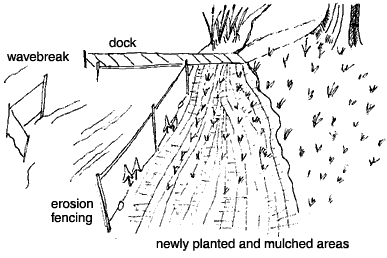
Table 2. Some common native plants.
|
Solidago species |
Aster Novae-anglia |

Ratabida pinnata |
Veronicastrum virginicum |
Liatris species |
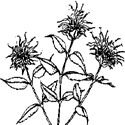
Monarda fistulosa |
Andropogon gerardii |
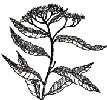
Verononia fasciculata |
Iris verisicolor |
Lobelia cardinalis |
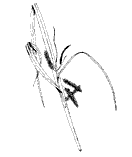
Carex comosa |
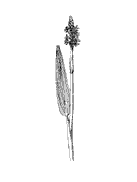
Pontederia cordata |
Sparganium americanum |
Alisma plantago-aquatica |
Sagitaria latifolia |
|
Typha latifolia |
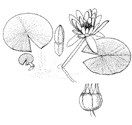
Nymphae odorata |
Valisneria american |

Nelumbo lutea |
![]()
Produced by Communication and Educational Technology Services, University of Minnesota Extension Service.
In accordance with the Americans with Disabilities Act, this material is available in alternative formats upon request. Please contact your University of Minnesota Extension Service office or the Distribution Center at (800) 876-8636.
The University of Minnesota Extension Service is committed to the policy that all persons shall have equal access to its programs, facilities, and employment without regard to race, color, creed, religion, national origin, sex, age, marital status, disability, public assistance status, veteran status, or sexual orientation.